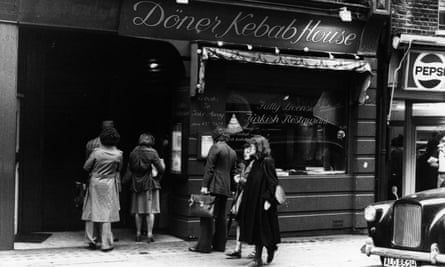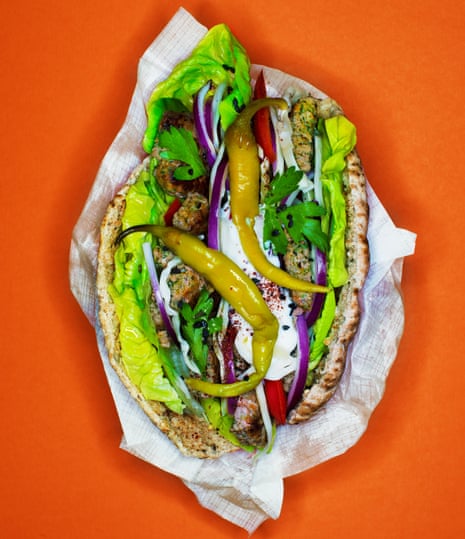Happy birthday to the humble kebab. The döner kebab has existed in Turkey for centuries, but there it arrives on the table as a heap of sliced meat on a plate with rice and vegetable sides. Exactly when, however, some Turkish immigrant in Europe had a burst of culinary inspiration, stuffing the meat and veg into a pocket of bread, thus transforming it into one of the world’s great street food items, is up for debate. Its origin is most often credited to either Mehmet Aygün or Kadir Nurman who, in 1971 and 1972 respectively, turned this Turkish dish into a street snack in West Berlin, though it is thought that the first kebab shop opened in London in 1966, making this its 50th year in existence.
In Berlin, where I live, one is never more than a pitta’s throw from a Turkish joint serving döner kebab sandwiches – places where the star of the show is a cow-sized hunk of meat turning on a spit like a culinary disco ball. The beef (or sometimes veal) is shaved off and, along with lettuce, onion, tomato and chilli sauce, layered into a pocket of flatbread.
Around the world, the döner kebab is part of that bibulous, inhibition-drowning, late-night landscape, functioning more as tummy filler than actual taste sensation. The appeal is the ubiquity of the kebab shop – we encounter them while stumbling home from a pub, everywhere from Sydney to San Francisco, Belfast to Beijing. I know this because I’ve done it often on my own travels.
But after sampling the kebab while sober, I’ve realised there’s much to appreciate about this Turkish-inspired snack. It could be the perfect sandwich: the juicy meat brings the savoury umami; the chilli sauce, the spice; the tomato offers an acidic touch; the yogurt-garlic sauce adds a creamy aspect; and the crisp, toasted bread gives the whole thing a textual crunch that is oh so pleasing on the palate.
Not all döners are created equal. Every “best kebab in Berlin” list, for example, inevitably includes Imren, Tadim and Mustafa’s. They’re all perfectly fine, but I’ve noticed each spot does one thing really well, each different from the others: Imren’s main attraction is the flavourful beef; Tadim is great for its toasted, fresh bread; and people wait in line for 45 minutes at Mustafa’s for its crisp, fresh veg. I often fantasise about concocting a döner using the best of these three spots, thus creating a kind of supreme döner kebab, a sandwich so good it almost seems mythical.
Like many great street food dishes, the döner kebab was born of larger forces in the world, particularly immigration traced back to post-Second World War Europe. In Germany, for example, Turks were invited to be gastarbeiter – guest workers – when the wirtschaftswunder, the economic miracle, called for labourers. Tens of thousands came. But as the economy soured in the 1970s, many recently laid-off Turks opened kebab shops.
Its rise tells us something about our globalised foodways and, in particular, about how Europe’s demographics have shifted in the past 50 years (and its population’s general acceptance of those changes). Today in Europe there are more than 200,000 people working in the kebab industry, grossing €3.5bn annually. Organisations such as the Association of Turkish Döner Manufacturers in Europe have sprung up to promote the dish and advocate for its workers. The kebab is now serious business.
And yet the perfect kebab still eluded me. But then I’d heard whispers about a place out on the border of Prenzlauer Berg and Friedrichshain called Meraba that served an excellent kebab – one with beef sourced from ethically treated, free-range cows. Could this be the edible white whale I’d been searching for? I had to find out.

With the sandwich in front of me, its dark fire-roasted meat, its spritely bright-green lettuce spilling out beyond the opening of the bread, I picked it up and took a bite. It had everything I was looking for in a döner kebab sandwich, a mythical golden döner: there was fresh, robust leafy green lettuce (not the usual tasteless iceberg variety); crispy bread that was thinner than normal thus less intrusive, letting the other ingredients emerge; and the meat exploded with flavour. Moreover, it was thinly sliced and charred to a crisp, a quality one rarely finds in cooked döner meat.
The sauces further emboldened the sandwich: spicy chilli, creamy garlic sauce and tangy mustard (an unusual but welcome addition), all conspiring to create added flavour strata.
I put the kebab down for a second and pondered what was in front of me. My quest was complete. The döner kebab will never graduate to the level of elevated food the way the hamburger has in the past decade, turning up on the menus of Michelin-starred restaurants. I highly doubt it will ever get stuffed with foie gras or sprinkled with truffles. But if Meraba’s fresh veggies and free range beef stuffed kebab is a harbinger for the future, I think late-night drunken eating just got a lot more delicious. And no better time than on the anniversary of the planet’s most perfect sandwich.

Comments (…)
Sign in or create your Guardian account to join the discussion